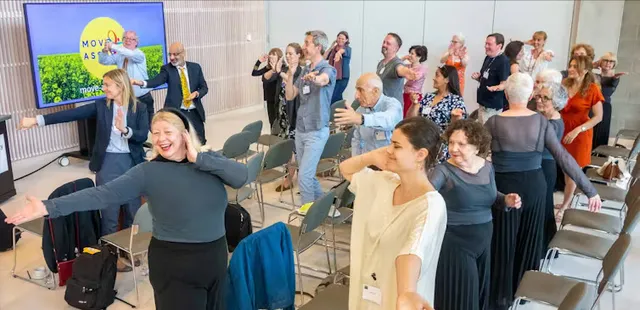
Breakdancing in the break room might not seem like the best way to get ahead at work, but research shows recreational dance can actually improve productivity performance in the workplace.
在休息室跳霹靂舞似乎不是在工作中出人頭地的最佳方式,但研究表明,娛樂性舞蹈實際上可以提高工作效率。
It is well known that engaging in physical activity has many health benefits – from reducing the risk of diabetes, to lowering the risk of developing coronary heart diseases and dementia. The World Health Organization (WHO) has even linked the increasing incidence of noncommunicable diseases (those characterised by slow progression and long duration) to unhealthy life styles.
眾所周知,參加體育鍛煉對健康有很多益處--從降低患糖尿病的風險,到降低患冠心病和癡呆癥的風險。世界衛生組織(WHO)甚至將非傳染性疾病(進展緩慢、持續時間長的疾病)發病率的上升與不健康的生活方式聯系起來。
If you still need motivation to move, there is evidence that a lack of physical exercise can result in lower earnings, and lower probability of finding employment or even being invited to interview.
如果您還需要運動的動力,那麽有證據表明,缺乏體育鍛煉會導致收入降低,找到工作或甚至被邀請參加面試的概率也會降低。
So, moving is good for you. But when it comes to work, our research shows that dance, in particular, could help you – and your company – get ahead.
因此,運動對你有好處。但在工作中,我們的研究表明,舞蹈尤其可以幫助你和你的公司取得成功。
Let’s dance
讓我們跳舞吧
Dance is special. Neuroscience and psychology researchers have not only recognised the positive health effects of dance but have also discovered that dancing has additional benefits compared to other forms of physical exercise. Cognitive psychologist – and dancer – Peter Lovatt explains that dance is a cognitive activity that engages the brain through learning dance routines, processing music and thinking about rhythm and coordination.
舞蹈很特別。神經科學和心理學研究人員不僅認識到舞蹈對健康的積極影響,還發現與其他形式的體育鍛煉相比,舞蹈具有更多的益處。認知心理學家兼舞蹈家彼得-洛瓦特解釋說,舞蹈是一種認知活動,它透過學習舞蹈動作、處理音樂以及思考節奏和協調性來調動大腦。
Several studies have focused on the benefits of dancing for the ageing brain and its effectiveness in improving quality of life among those affected by degenerative conditions such as Parkinson's disease. And while there have been no specific studies on the economics of dance, research tends to relate cognitive skills to higher wages and productivity.
有幾項研究重點關註了舞蹈對大腦老化的益處,以及舞蹈在改善帕金森病等退化性疾病患者生活質素方面的有效性。雖然還沒有關於舞蹈經濟學的具體研究,但研究傾向於將認知技能與更高的薪水與生產力聯系起來。
And so, because it improves cognitive abilities, we believe dance can also improve productivity in the workplace.
因此,由於舞蹈能提高認知能力,我們相信舞蹈也能提高工作場所的生產力。

The workplace benefits of dance
舞蹈的職場益處
To show this, we used a survey-based approach to collect data from a sample of dancers located in Italy, the UK and Brazil. We also collected data from a control group from the same three countries – these participants actively exercise but do not dance.
為了證明這一點,我們采用了一種基於調查的方法,從意大利、英國和巴西的舞者樣本中收集數據。我們還從這三個國家的對照組中收集了數據--這些參與者積極鍛煉但不跳舞。
To measure performance in the workplace, we used a selection of questions on absenteeism (not turning up to work) and presenteeism (not working as hard as usual when at work).
為了衡量工作場所的表現,我們選取了一些關於曠工(不上班)和缺勤(上班時沒有像平時一樣努力工作)的問題。
We picked five questions from the WHO's Health and Work Performance questionnaire to measure presenteeism: how often respondents have not worked when they were supposed to, how often they have not worked carefully, how often their work has been of poor quality, how often they have not been concentrating while working, and how they self-rate their job performance.
我們從世界衛生組織的 "健康與工作表現 "問卷中選取了五個問題來衡量曠工現象:受訪者在應該工作的時間沒有工作的頻率、沒有認真工作的頻率、工作質素不高的頻率、工作時註意力不集中的頻率以及對工作表現的自我評價。
To evaluate absenteeism, we used respondents' reports about how many times they had missed a whole day of work (or part of a day) for health reasons and for non-health related reasons over the week prior to the survey.
為了評估缺勤情況,我們使用了受訪者的報告,即在調查前一周內,他們因健康原因和非健康原因缺勤一整天(或一天中的部份時間)的次數。
For a more meaningful comparison of productivity performance, we matched each dancer with a non-dancer with similar personal and job characteristics. This way, the only observable difference between the matched participants is how they exercise. So, any differences in productivity could be due to dance.
為了對生產績效進行更有意義的比較,我們將每位舞者與具有相似個人和工作特征的非舞者進行配對。這樣,配對參與者之間唯一可觀察到的差異就是他們的鍛煉方式。因此,生產力上的任何差異都可能是舞蹈造成的。
We found that presenteeism is lower among dancers compared to non-dancers. We also found that dancers are more productive compared to non-dancers because they exhibit less absenteeism.
我們發現,與非舞蹈演員相比,舞蹈演員的曠工率較低。我們還發現,與非舞蹈演員相比,舞蹈演員的工作效率更高,因為他們的缺勤率更低。
Dance or wellbeing – or both?
舞蹈還是健康--或者兩者兼而有之?
So, the research indicates that dance could improve productivity directly through enhanced cognitive abilities. But there are other potential ways that doing a few pirouettes could benefit you at work.
因此,研究表明,舞蹈可以透過提高認知能力直接提高工作效率。不過,跳幾個回旋舞還有其他潛在的方法,可以讓你在工作中受益。
Several studies have found a positive relationship between wellbeing and performance in the workplace. This makes sense. If you feel happy and satisfied with your life, you’re more likely to concentrate on your work tasks and perform them more effectively, possibly because you're less distracted.
多項研究發現,工作場所的幸福感與工作表現之間存在正相關關系。這是有道理的。如果你對自己的生活感到快樂和滿意,你就更有可能集中精力完成工作任務,並更有效地完成任務,這可能是因為你分心較少。
Equally, scholars have identified a positive relationship between dance and wellbeing. We also found that the dancers in our sample enjoy higher levels of wellbeing compared to the non-dancers. So, our results could simply indicate that dance improves wellbeing, and wellbeing leads to higher productivity, rather than dance improving productivity directly.
同樣,學者們也發現了舞蹈與幸福之間的積極關系。我們還發現,與不跳舞的人相比,樣本中跳舞的人享有更高的幸福感。因此,我們的研究結果可能只是表明,舞蹈能提高幸福感,而幸福感能提高生產力,而不是舞蹈能直接提高生產力。
To probe this issue further, we compared dancers and non-dancers who match in terms of other personal and job characteristics, but who also have similar levels of wellbeing. After controlling for wellbeing like this, we found dancers still perform better in terms of presenteeism and absenteeism. This suggests that the positive correlation between dance and productivity goes beyond the well-known wellbeing effects. Dance has a direct effect on worker productivity, it's not just making dancers feel happier.
為了進一步探究這個問題,我們比較了在其他個人和工作特征方面相匹配但幸福感水平相似的舞蹈演員和非舞蹈演員。在對幸福感進行這樣的設定後,我們發現舞蹈演員在出席率和缺勤率方面的表現仍然更好。這表明,舞蹈與生產力之間的正相關關系超出了眾所周知的幸福感效應。舞蹈對工人的工作效率有直接影響,它不僅僅讓舞者感覺更快樂。

Who benefits from dancing at work?
誰能從工作時跳舞中受益?
The productivity difference between dancers and non-dancers is most concentrated in respondents with jobs involving below average levels of cognitive tasks and above average levels of routine tasks, such as packaging, package delivery or payment processing. It's reasonable to assume that this group is not cognitively stimulated at work, so dancing seems to provide a way of improving cognitive skills which, in turn, affects their performance.
跳舞者與非跳舞者之間的生產力差異最集中地體現在那些從事認知任務低於平均水平、日常任務高於平均水平的工作的受訪者身上,如包裝、包裹遞送或付款處理。我們有理由認為,這部份人在工作中沒有受到認知刺激,因此舞蹈似乎提供了一種提高認知能力的途徑,進而影響了他們的工作表現。
The productivity-enhancing effect of dance is also stronger in activities involving high levels of teamwork. Also, although the matched male sample is rather small, our results suggest that men who practice recreational dance benefit more than women in terms of presenteeism and absenteeism.
在涉及高度團隊合作的活動中,舞蹈對提高生產力的影響也更大。此外,雖然匹配的男性樣本較少,但我們的結果表明,在出席率和缺勤率方面,練習娛樂舞蹈的男性比女性受益更多。
The relationship between dance and presenteeism or absenteeism is very important economically. The annual cost of poor mental health for UK employers could be as much as £45 billion, according to research by Deloitte. A large part of this cost arises from presenteeism and absenteeism. So, a workplace dance intervention could help reduce such costs, as well as being beneficial for workers.
舞蹈與曠工或缺勤之間的關系在經濟上非常重要。根據德勤公司的研究,英國雇主每年因心理健康狀況不佳而付出的代價可能高達 450 億英鎊。其中很大一部份成本來自於曠工和缺勤。因此,工作場所舞蹈幹預可以幫助降低這些成本,同時也對員工有益。
Dancing is a universal activity, it's part of the cultural heritage of most countries. It could be used worldwide to promote health and performance in the workplace as well.
舞蹈是一項世界性的活動,是大多數國家文化遺產的一部份。它也可以在全球範圍內用於促進健康和工作場所的績效。











